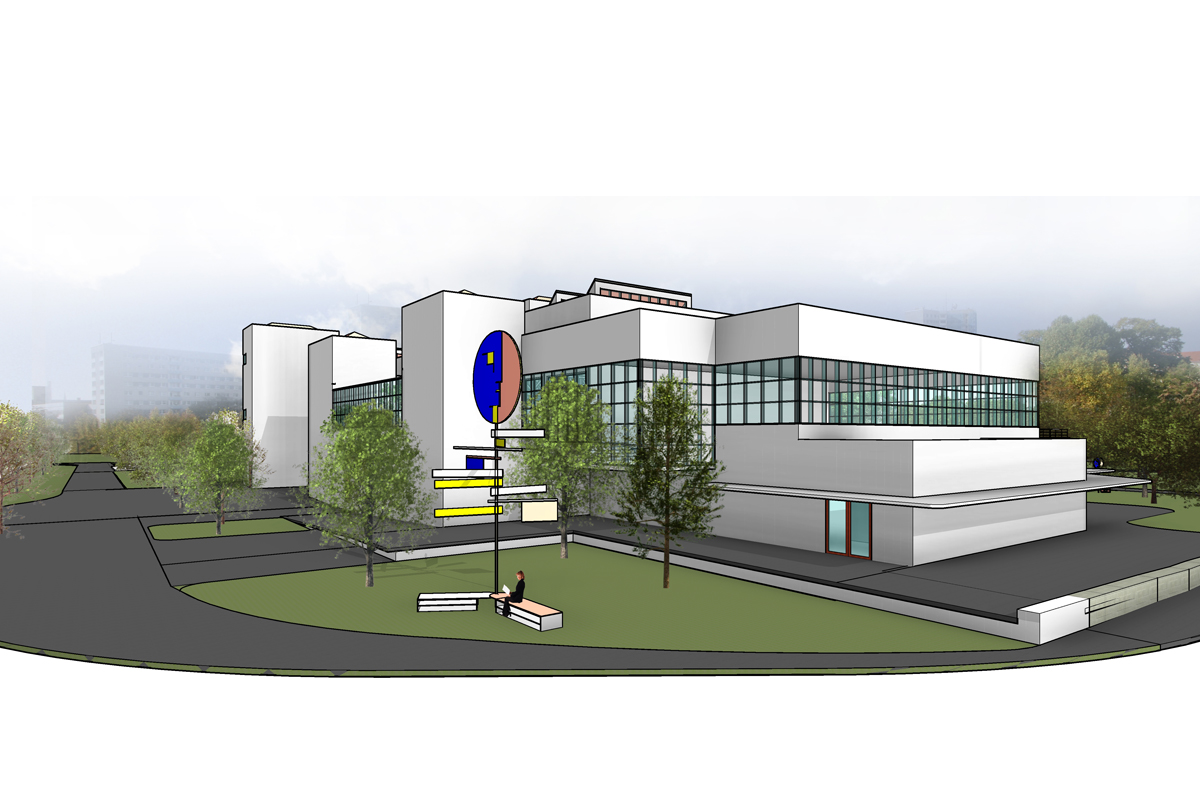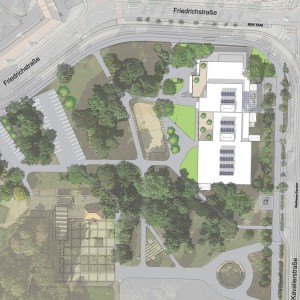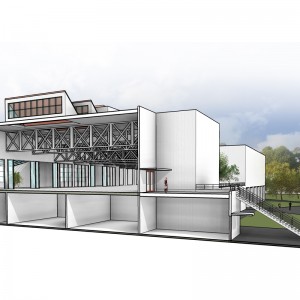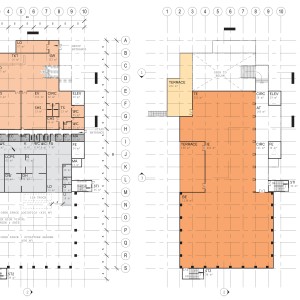
Bauhaus Museum Dessau Competition Entry
The location of the museum entry and outdoor terraces at the north end of the site, with the rest of the program elements directly behind, near the intersection of Kavaliestraβe and Friedrichstraβe, creates a spatial node that announces the new museum to the city. Pedestrians and bicycle riders as well as those riding in motor vehicles, street cars and Lorries can see it as they pass by, becoming familiar and establishing a recognizable symbol, a clear and familiar view that will provide linkage of the City Park and Museum to the rest of the city. This location also allows interacting with the tree inventory as sensitively as possible.
The everyday functions, visitor’s service, museum education, administration, and logistics are on the ground floor. The upper floor is reserved for just enjoying the collection. No set circulation has been created anticipating open sight lines between the galleries. Also located on the upper floor is an enclosed Atrium. Located on the east side of the building , it will be flooded with natural light during the morning hours. An “afternoon” open deck and the dining terrace are located on the west side. These expansive and bright spaces bring the park to the exhibition level and provide natural light. Additional natural light will be available overhead through the north facing clerestories, above the trusses, that will be regulated with mechanical louvers and frosted acrylic panels. The south facing roof of the clerestories will include solar panels to provide an alternative energy source for the museum. The entire ceiling system above the exhibition areas will be calibrated to control and regulate natural light and provide the required flexible artificial lighting grid required in museums as well as climate control ducting systems.
The main pedestrian access points to the museum will be via the existing park entrances at the north, to the left and right of Antoinetten-Straβe, in front of Ftritz-Hesse- Straβe on the west and directly in line with Ratsgasse on the east. The Main Entrance along with the staff entrance and access to the store and restaurant are located on the west side of the museum. The group entrance is located on the east side of the museum. At this location we have chosen to preserve the pie shape planted area where the park and the city meet and blend into each other. We think that the ambiguity of what is city and what is park at this location is interesting and worth maintaining.
Parking for 50 vehicles, including 2 van accessible disabled spaces, are provided in the designated preferred car park area and deliveries will be routed via the path located to the south adjacent to the car park. The museum’s logistics department, distribution warehouse and storage functions are located at the south end of the museum structure and align with this route.
We envision exhibit installations at most of the parks’ open meadows. Both temporary and permanent displays in the open space will enhance both culture and recreation. While we have not directly addressed this design component, we will during the next stage when we bring a landscape architect to the team.
The museum will announce itself and provide legible and inviting gestures in the open area leading up to the park. A guide company, colorful figures built out of metal and skillfully detailed, will locate along the Elbe by Corn House, the Törten estate and the Steel House, Master’s House and the Bauhause, on streets and sidewalks near town hall, the Anhat Theater, Dessau Railway Stations and trading and service facilities to wayfind and announce guests to the park. A hint of how a guide may appear is presented in the design proposal with the acknowledgement that careful definition is needed with regards to branding and constructing of the company.
Physically the museum is a cast-in-place white gleaming concrete structure. It includes a concrete slab on grade at the lower level and a structural slab at the second level. Both slabs will have heating coils embedded in various zones that will provide radiant heating to the entire museum. Long span exposed metal deck with unmatched acoustic characteristics, such as made by Epic Metals will be used for the roof. The metal deck profile will include a hanging feature to accommodate signage, lighting and utility systems. The metal deck will be supported throughout by 3m high metal trusses with a span of 20m to 38m supported by concrete pilasters creating column free exhibitions galleries for maximum flexibility. The foundation system will be piles either bored piles or micro-piles for minimum impact on the park. The aim is to create expansive and bright interior spaces of architectural clarity by careful streamlining and keeping internal clutter to a minimum.
The exterior walls will be cast-in-place white concrete with R-19, XPS insulation on the interior surfaces. Glazing will be engineered laminated glass with an interlayer film to reduce heat gain, control ultraviolet radiation and provide the desired color light with the greatest transparency.
Sustainable building features will include among others; cool roofs, radiant heating, solar panels, rain water recycling into cisterns located at the top of the stairs and elevator towers, engineered glazing, energy efficient lighting and controls, thermal mass,
The Bauhaus in the 21st Century appears as relevant as it was when at its height in the first half of the 20th Century. The well-known epochal designs we celebrate today fulfill today’s aesthetic requirements and appear as contemporary as ever. The Bauhaus process of design and manufacture that guides the educational concept and the origin of its creativity seem unsurpassed since inception. No rethinking is needed here.
In the 21st Century we are starting to develop a longing for unplugging from technology, digital detox, slow-down not start-up, to be here now, be human, and connect with our fellow humans. As very well stated in the Competition Brief, “The Bauhaus did not just stand for a radical new presentation and way of life. Above all, the Bauhaus was a completely new kind of school which did not pass on assured knowledge but devised and created new knowledge. It involved a new view, a new aesthetic, a new pedagogy and the application of new materials and technologies for a new function of all areas of life. Art, design and architecture belonged together for everyone. It was about nothing less than the revolution of everyday life.” We suggest actualization as follows: The Bauhaus does not just stand for a radical new presentation and way of life. Above all, the Bauhaus is a completely new kind of school which does not pass on assured knowledge but devises and creates new knowledge. It involves a new view, a new aesthetic, a new pedagogy and the application of new materials and technologies for a new function of all areas of life. Art, design and architecture belonged together for everyone. It was about nothing less than the revolution of everyday life. The challenge today then is not about actualization and relevance in contemporary times, it is about resetting individual thinking to make this actual and real, to make it come about.View Presentation Board (PDF, 4MB)











